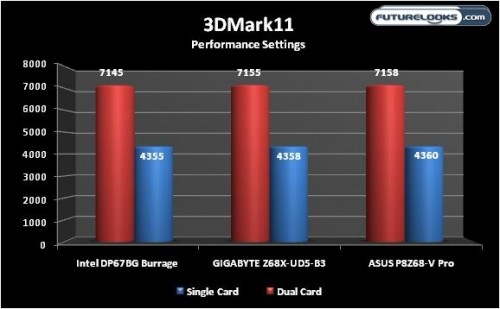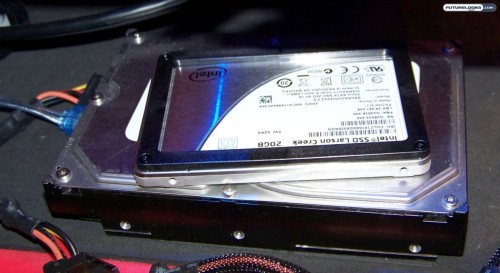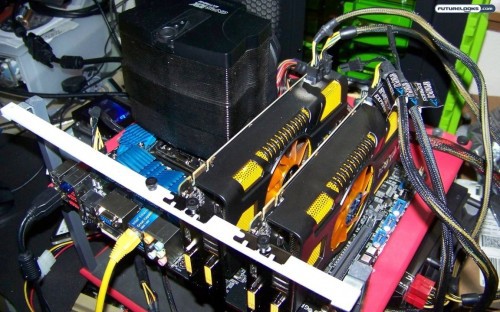Does Virtu Benefit 3DMark11 Performance?
To answer this question, three iterations of 3DMark11 were performed on each motherboard using the same graphics. Using the Performance setting, averages are reported in the graph.
Based on our results, there is no performance benefit to graphics. It doesn’t matter if the motherboard supports both features or not. However, you will get quicker program load times as Smart Response learns which game you play the most. If it’s just games you’re wanting and nothing else, then you have your answer. Test results are also showing that there is no reason why a top end board should not be offered with the Virtu technology as it does not impede performance in any way.
What About Program Load and Boot Times?
How fast your programs load depends on your SSD’s transfer rate performance. That’s how Intel Smart Response works. It keeps track and caches programs that you use repeatedly. Because we’re running repeated Sysmark 2007 benchmarks, the load times decreased each time it ran and the scores increased as a result. Battlefield Bad Company 2 also started loading a little quicker each time it was restarted. However, frame rates in preliminary testing did not increase. Since, system restarts are a very common thing we do around here, we observed about a 30% reduction in boot times on average.
Since your mileage will vary based on the SSD you choose, boot and program load times can shorten even further. Again, we’ll do some comparison tests for you later as we get more 30 to 64GB SSDs. In the meantime, if you buy a Z68 system, make sure you enable RAID before installing the OS as mentioned in our setup walk through. You will thank us later.
The Z68 Perspective
It really is cool in a strange way seeing an INTEL Z68 motherboards with integrated video flexing huge guns. The Z68 chipset offers both the performance and connectivity of P67 and H67 chipsets. Despite limited program support for Sandy Bridge’s Intel Quick Sync capability, LucidLogix Virtu gives users a plug and play option of utilizing the discreet and integrated graphics at the same time. You can task out the IGP for productive purposes and use your video card for your gaming. Or you can even split monitors and save some video card resources, letting the IGP do the 2D thing while your discrete GPU do its 3D thing.
The real benefit of Z68 comes from Intel Smart Response. Our performance numbers alone validate the hunch that professional users and content creators will benefit the most once they get it setup. Refer to our set up section for clarification though as this will save you some time and frustration. However, It won’t benefit gamers so much other than quicker game loading times. So, if you’re a P67 gamer, you can stay right where you are at for the moment.
We do have a couple reservations in regards to high performance motherboards like the GIGABYTE Z68X-UD5 that do not offer Virtu. Our own findings revealed that there was no penalty for including it. We can’t help but feel there’s less value in a $269 platform that’s missing support for a staple feature unless it offers some other tangible replacement like higher end audio or 3-way NVIDIA SLI. The only apparent upgrade are 6 GBps eSATA ports. But if you use eSATA a lot, then I guess that’s a benefit.
The INTEL Z68 series breaks tradition by giving you a high end offering with an IGP, that doesn’t suck. All the performance is there along with much better implementation of INTEL Quick Sync thanks to Virtu technology. The increased hard drive and system responsiveness via Smart Response is especially welcome. If you’re looking for a more productive computing experience, Z68 is a great alternative to P67 or X58 systems. Stay tuned for our round up of Z68s top boards later on!
Help Us Improve Our Articles By Leaving a Comment Below!



